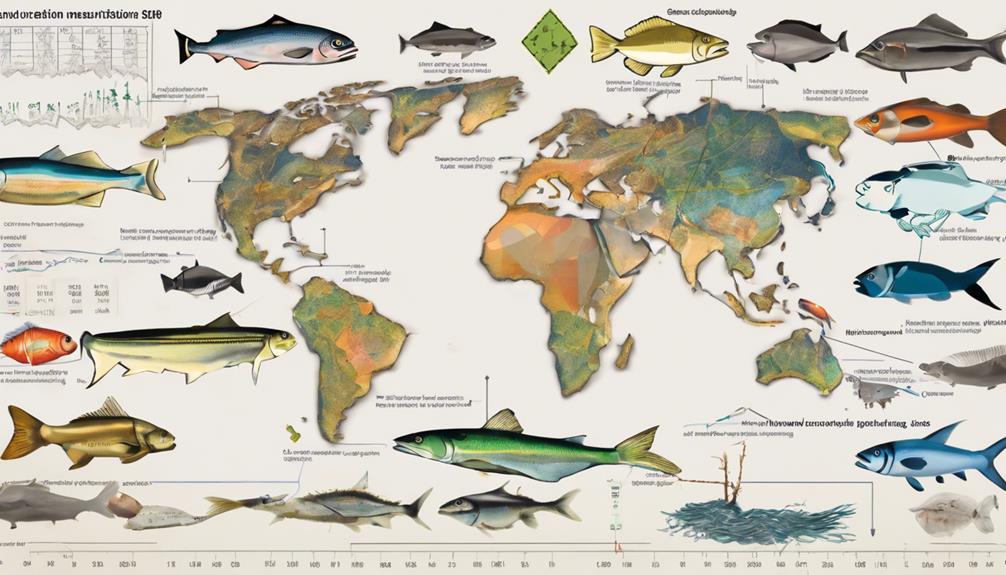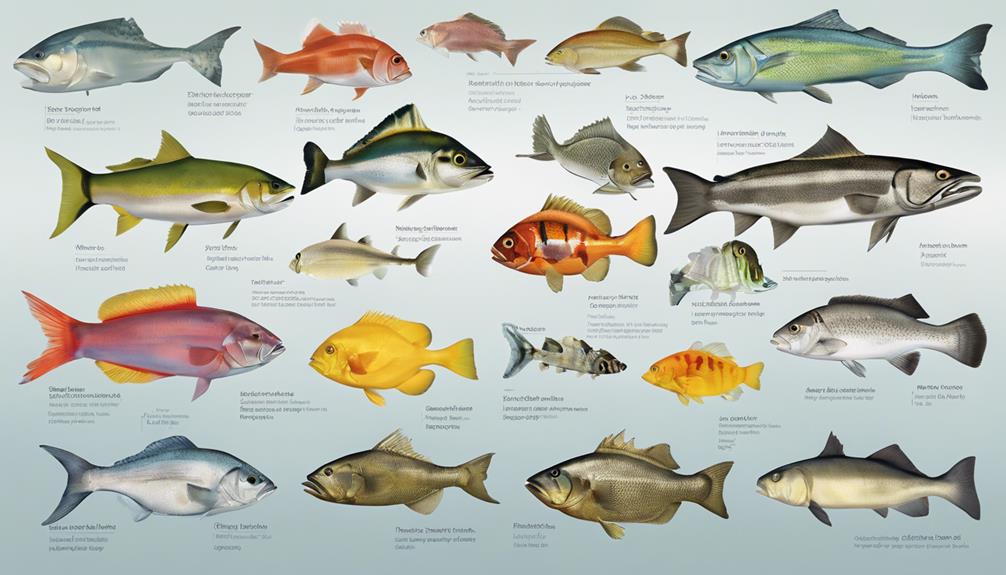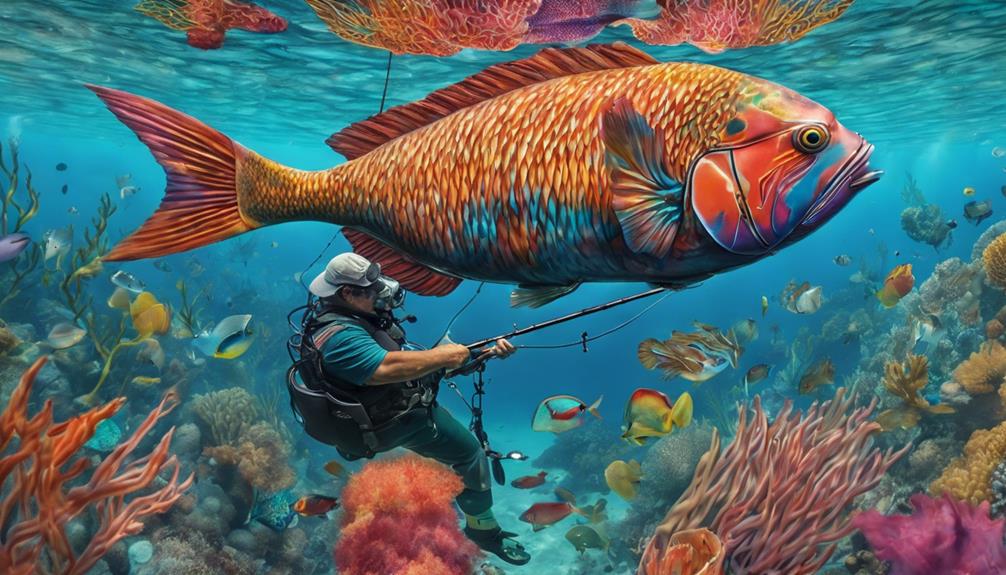When it comes to navigating the waters of species-specific fishing regulations, think of yourself as a vigilant captain steering through a sea of conservation. Each practice serves as a crucial anchor in preserving the delicate balance of aquatic ecosystems.
From understanding the behavioral patterns of target species to effectively implementing size limits, these strategies form the backbone of sustainable fishing management. But there's one key aspect that ties them all together, ensuring success.
Curious to discover the linchpin that can make or break these regulations?
Importance of Species-Specific Regulations
Understanding the rationale behind species-specific regulations is crucial for effective fisheries management. These regulations aren't arbitrary but are designed to address specific concerns related to the conservation impact and ecological balance of the marine environment. By tailoring regulations to different species, authorities can better protect vulnerable populations and ensure the overall health of the ecosystem.
Conservation impact is a key consideration when implementing species-specific regulations. Certain species may be more susceptible to overfishing, either due to their biological characteristics or existing population levels. By setting limits on catch sizes, fishing seasons, or gear types for these species, regulators can help prevent their decline and promote sustainability in the long term. This proactive approach is essential for maintaining biodiversity and preserving the delicate balance of marine ecosystems.
Moreover, species-specific regulations play a crucial role in maintaining ecological balance. Each species contributes uniquely to the food web and ecosystem dynamics. Overexploitation of a particular species can have ripple effects throughout the ecosystem, impacting predator-prey relationships and overall biodiversity. By managing fishing activities with a species-specific lens, regulators can minimize disruptions to the natural balance of marine ecosystems, promoting resilience and stability in the face of environmental challenges. Ultimately, these regulations serve as a tool to ensure that fishing practices align with the broader goals of conservation and sustainable resource management.
Understanding Target Species Behavior
To effectively manage your fishing practices, gaining insight into the behavior of your target species is essential. Understanding feeding habits and migration patterns can significantly enhance your fishing success. Here are some key points to consider:
- Feeding Habits: Knowing what your target species eats can help you choose the right bait or lures. Different species have varied feeding preferences, such as carnivorous, herbivorous, or omnivorous diets.
- Migration Patterns: Understanding when and where your target species migrates can aid in locating them more efficiently. Some species migrate seasonally for spawning or in search of food, while others may follow specific routes.
- Adaptability: Species may change their feeding habits based on environmental factors. Being adaptable in your approach can increase your chances of a successful catch.
- Reproductive Cycles: Knowledge of spawning seasons can help you avoid fishing during critical breeding times, ensuring the sustainability of the species.
- Habitat Preferences: Different species have specific habitat preferences. Understanding these preferences can guide you to the right fishing spots for your target species.
Implementing Size Limits Effectively
Consider setting size limits for your catch to promote sustainable fishing practices and protect the population of your target species. Implementing size limits effectively is crucial in ensuring the longevity of fish populations. To maximize compliance with size regulations, it's essential to educate anglers about the benefits of adhering to these limits. By promoting sustainability through size restrictions, you contribute to the conservation of fish stocks for future generations.
One effective way to implement size limits is by clearly displaying regulations at fishing spots and providing educational materials that explain the reasoning behind these restrictions. Additionally, incorporating size limit information into fishing permits or licenses can serve as a constant reminder to anglers. Regular monitoring and enforcement of size limits help deter non-compliance and reinforce the importance of these regulations.
To further enhance compliance and promote sustainability, consider organizing outreach programs or workshops that focus on responsible fishing practices, including the significance of size limits. Engaging with local fishing communities and collaborating with conservation organizations can also raise awareness and encourage a collective effort towards protecting fish populations.
Setting Catch Limits Appropriately
Setting catch limits appropriately is crucial for maintaining healthy fish populations and sustainable fishing practices. To achieve this, it's essential to consider several key factors:
- Data driven assessments: Catch limits should be based on scientific data regarding fish populations, reproduction rates, and environmental factors. This ensures that limits are set at levels that support population growth and sustainability.
- Sustainability goals: Catch limits should align with sustainability goals to prevent overfishing and ensure the long-term health of fish stocks. By setting appropriate limits, fishing can continue without depleting resources.
- Ecosystem impact: Catch limits should take into account the broader ecosystem impact of fishing activities. Setting limits too high can disrupt the balance of marine life and lead to unintended consequences.
- Stakeholder input: Involving stakeholders such as fishermen, scientists, and conservationists in the process of setting catch limits can lead to more informed decisions. Their input can provide valuable perspectives on the potential impacts of different limits.
Protecting Critical Spawning Areas
Protect critical spawning areas to safeguard the future of fish populations and ensure sustainable fishing practices. Habitat preservation is crucial in maintaining the delicate balance of ecosystems. By protecting these vital areas where fish spawn, you contribute to the overall health of fish populations. Conservation efforts aimed at preserving these habitats play a key role in ensuring the sustainability of fish stocks for future generations.
Population sustainability heavily relies on the availability of suitable spawning grounds. Disturbances to these critical areas can have detrimental effects on fish populations, leading to a decline in numbers and potentially endangering certain species. Environmental impact assessments should be conducted to evaluate the effects of human activities on these spawning areas and implement measures to minimize harm.
Conserving critical spawning habitats not only benefits the fish populations but also contributes to the overall health of the marine ecosystem. By protecting these areas, you're supporting biodiversity and helping maintain the balance of marine life. Your efforts in safeguarding these crucial locations have a direct impact on the long-term viability of fish populations and the sustainability of fishing practices. Remember, the future of fishing depends on the preservation of these critical spawning areas.
Enforcing Gear Restrictions Strategically
To ensure the effectiveness of conservation efforts in safeguarding critical spawning areas, strategic enforcement of gear restrictions is essential for promoting sustainable fishing practices. By strategically enforcing gear restrictions, authorities can better protect vulnerable species and ensure the long-term health of marine ecosystems.
Here are some key points to consider for enforcing gear restrictions effectively:
- Targeted Patrols: Conduct targeted patrols in known hotspots where illegal fishing activities are prevalent to maximize enforcement efforts.
- Technology Integration: Utilize technology such as GPS tracking systems and underwater drones to monitor fishing activities and detect any violations promptly.
- Community Engagement: Involve local communities in reporting illegal fishing practices and raise awareness about the importance of complying with gear restrictions.
- Collaborative Partnerships: Collaborate with other enforcement agencies, NGOs, and research institutions to share information and resources for more effective enforcement.
- Penalties and Incentives: Implement strict penalties for violators of gear restrictions while providing incentives for compliance to create a deterrent effect and encourage responsible fishing practices.
Monitoring and Evaluating Regulations

When evaluating the effectiveness of fishing regulations, monitoring plays a crucial role in ensuring compliance and assessing the impact on marine ecosystems. Data analysis is essential for understanding trends in fish populations and the overall health of the ecosystem. By collecting and analyzing data on catch sizes, species composition, and habitat impacts, regulators can make informed decisions to protect vulnerable species and habitats.
Compliance rates are a key indicator of how well fishing regulations are being followed. Monitoring activities, such as onboard observer programs and electronic monitoring systems, can help track compliance and detect any illegal or unsustainable fishing practices. By regularly assessing compliance rates, regulators can identify areas where enforcement efforts need to be strengthened and where additional support or education for fishers may be necessary.
Effective monitoring and evaluation of fishing regulations require collaboration between scientists, regulators, and fishers. By engaging stakeholders in the monitoring process, regulators can gather valuable insights and data that can improve the design and implementation of regulations. Open communication and transparent data sharing are essential for building trust and ensuring that regulations are effective in achieving their intended conservation goals.
Engaging Stakeholders for Success
Engaging stakeholders actively in the development and implementation of fishing regulations is crucial for their success. Collaborative partnerships and stakeholder engagement are key components in ensuring that regulations are well-received and effectively enforced. When stakeholders are involved from the beginning, they feel a sense of ownership and are more likely to comply with the regulations. Community involvement is essential as it brings together diverse perspectives and ensures that the regulations take into account the needs and concerns of all parties involved. Effective communication strategies are vital for keeping stakeholders informed about the regulations, the reasons behind them, and any updates or changes that may occur.
Key Points for Successful Stakeholder Engagement:
- Build Collaborative Partnerships: Work together with stakeholders to develop regulations that are fair and feasible.
- Ensure Stakeholder Engagement: Involve all relevant parties in the decision-making process to increase buy-in and compliance.
- Promote Community Involvement: Create opportunities for community members to provide input and feedback on the regulations.
- Implement Effective Communication Strategies: Keep stakeholders informed through clear and transparent communication channels.
- Encourage Continuous Feedback: Establish mechanisms for ongoing dialogue and feedback to address any issues that may arise.
Frequently Asked Questions
How Do Species-Specific Fishing Regulations Impact the Overall Ecosystem Health?
When you consider species-specific fishing regulations, you directly influence the overall ecosystem health. By safeguarding certain species, you aid in biodiversity preservation and maintain ecosystem balance.
These regulations support sustainable management and conservation efforts, ensuring that fish populations remain stable and thriving. Your role in adhering to these rules contributes to the long-term health of the ecosystem and the sustainability of marine resources.
What Are the Potential Consequences of Not Following Species-Specific Regulations?
If you don't follow species-specific regulations, negative impacts on fish populations and the ecosystem can occur. Enforcement challenges arise when rules aren't adhered to, making it difficult to manage resources sustainably.
How Do Species-Specific Regulations Vary Between Different Regions or Countries?
In different regions or countries, species-specific fishing regulations vary due to distinct environmental needs and fish populations. Enforcement challenges arise from resource limitations and varying cultural attitudes towards conservation.
Political influences also impact the stringency and implementation of these rules. Understanding regional differences is crucial in developing effective regulations that are both sustainable and respectful of local practices and beliefs.
How Can Recreational and Commercial Fishermen Work Together to Ensure the Success of Species-Specific Regulations?
To ensure the success of species-specific regulations, collaborative efforts between recreational and commercial fishermen are key. By working together, both groups can support conservation measures and help protect vulnerable species.
Sharing knowledge, following guidelines, and communicating effectively are essential for maintaining sustainable fishing practices. Remember, when fishermen unite for a common goal, it benefits everyone and ensures the long-term health of our oceans and marine life.
What Are Some Innovative Technologies or Methods Being Used to Enforce Species-Specific Regulations Effectively?
When it comes to enforcing species-specific fishing regulations, technological advancements have revolutionized the way authorities monitor compliance.
Innovative tools like GPS trackers, underwater drones, and satellite imaging are being utilized to keep a close eye on fishing activities.
These enforcement methods enable real-time surveillance and help ensure that regulations are being followed effectively, ultimately contributing to the sustainability of marine species.
Conclusion
Overall, implementing species-specific fishing regulations is crucial for sustainable fisheries management. By understanding the behavior of target species, setting appropriate size and catch limits, and protecting critical spawning areas, we can ensure the long-term health of fish populations.
Enforcing gear restrictions and actively monitoring regulations are also key components in successful management. By engaging stakeholders and continuously evaluating the effectiveness of regulations, we can work towards preserving our marine ecosystems for future generations.



